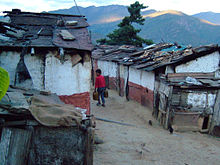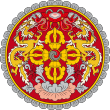Squatting in Bhutan


In 2001, about 10 per cent of the population of Bhutan's capital city Thimphu were living in squatted informal settlements; by 2019, the figure had dropped to 2 per cent since the squatters had been rehoused.[1] There are also rudimentary settlements on the periphery of other cities such as Phuntsholing and Samdrup Jongkhar.[1][2] The inhabitants work as manual labourers or in the informal economy.[3]
There are forest squatters in the south of Bhutan on the border with India: in 2016, evictions led to riots in Chirang district, in the Bodoland Territorial Region; [4] in Kokrajhar district, entrepreneurs clear forest land and sell the right the live there to people who become de facto squatters.[5] In the 1990s, a process of ethnic cleansing in the south of Bhutan led to around 100,000 Lhotshampa (Bhutanese people of Nepalese descent) being driven into Nepal, where they either squat or live in refugee camps.[6]
References
[edit]- ^ a b Bhutan Urban Policy Notes: Affordable Housing Policy. 2019. Archived from the original on 20 April 2022. Retrieved 2 May 2022.
- ^ Burisch, Michael (1988). "Industrialization and Industrial Estates in the Kingdom of Bhutan". Zeitschrift für Wirtschaftsgeographie. 32 (1): 33–52. doi:10.1515/zfw.1988.0003. S2CID 201672071.
- ^ National Report (PDF). Bhutan: Ministry of Works and Human Settlement Royal Government of Bhutan. 2016. Archived (PDF) from the original on 28 August 2020. Retrieved 2 May 2022.
- ^ Choudhury, Preetam B. (17 September 2016). "Bandh over eviction in Assam". Telegraph India. Archived from the original on 30 April 2022. Retrieved 30 April 2022.
- ^ Dutta, Anwesha (3 July 2018). "Rural informalities and forest squatters in the reserved forests of Assam, India". Critical Asian Studies. 50 (3): 353–374. doi:10.1080/14672715.2018.1479646. S2CID 149706401.
- ^ Douglas, Ed (24 June 2001). "Nepal's Bhutanese 'forgotten' refugees". The Guardian. Archived from the original on 30 April 2022. Retrieved 2 May 2022.


 French
French Deutsch
Deutsch